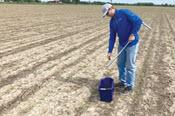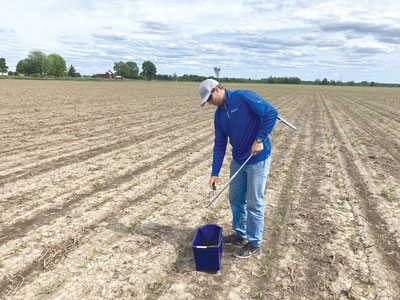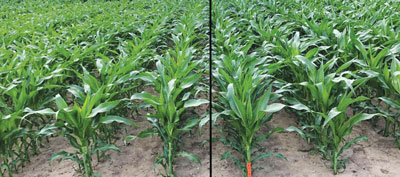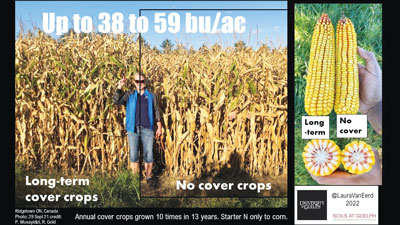
By Paul Hermans
We in agriculture are lucky. Every year we can look back at our growing season and learn new management strategies to enhance yields in the upcoming one.
This past winter I attended various agronomy conferences aimed at gleaning “some new tricks.”
Here are some of my favourite learnings that highlight research ideas from key industry, academic and likeminded individuals.
Keep in mind there were many more great topics presented, to which many a reader can attest.
Soybean cyst nematode
Soybean cyst nematode (SCN) is one of the most devasting pests we have in soybeans.
Southern Ontario has been battling with this microscopic roundworm for decades.
In Eastern Ontario we are starting to see pockets of soybean cyst moving in.
The U.S. Pioneer agronomy team has shared these interesting facts:
- Even with best management practices, 2022 Soil SCN sampling in the U.S. shows SCN is not going away.
- In 2017 121 million bushels were lost to SCN.
- The best way to determine if you have SCN is to take a soil test checking for SCN eggs.
- For every, one thousand eggs that are in the soil at planting, expect a 1 to 2.5-bushel yield loss.
- Crop rotation is key to beating this pest.
- Utilizing SCN resistant genes like PI 88788 or Peking in your soybean lineup assists with SCN defense.
- New management tools, like nematode-resistant soybeans, are on the horizon.
- In the near-term, crop rotation and utilizing exciting SCN genes, along with other best management practices, are key to controlling this pest.
Maximizing corn yields
Joe Lauer, longtime corn researcher at the University of Wisconsin, has these top tips for higher yields.
- Hybrid selection is key. At University of Wisconsin trials done over a 50-year period, there has been on average a 72-bushel difference in the top-yielding versus lowest-yielding hybrids.
- The average lifespan of hybrids today is two to three years. Hybrids change quickly and growers must adapt to changing products annually. If you are growing an out-of-date hybrid, you could be costing yourself a lot of yield.
- The top three things to consider when looking for higher corn yields are:
- Hybrid selection,
- Having a sound fertility program,
- Pest control.
- Fungicide payback is determinate on yearly disease/weather patterns.
Hybrid selection is dear to my heart. Placing the right product on the right acre can mean big yield gains.
Over the years I have asked growers how much yield difference can be attributed to placing a hybrid on the wrong acre. Many would say five to 10 to even 20 bushels.
There is still time to finalize cropping plans before the planters roll.
Changing weather patterns
Dr. Aaron Wilson from Ohio State University provided some interesting views on weather at the annual CCA conference in January in London.
- In 2022 up to 40 per cent of Ohio’s rainfall fell in fewer than 10 days – not consecutive days, but over the calendar year. These events are heavier in nature (amount) and over a shorter period.
- Meteorologists refer to Earth as a “water world,” as water encompasses more area than land does. As we increase global warming, more evaporation occurs.
- Annual precipitation increased 9.7 per cent in Ontario from 1948 to 2012. The biggest increase has been in the fall (17.8 per cent) and winter (5.2 per cent) seasons.
- Ontario is moving toward Ohio’s climate, Ohio toward Kentucky.
- Dr. Wilson mentioned “harvesting water as a crop.” With different rain patterns it may be feasible to store water and irrigate/subirrigate as needed.
- Our growing season is getting longer. For growers that means less frost and more frost-free days to harvest a crop. Maturity selection is increasing as a result.
- Challenges include increases in weeds, insects, and diseases, and greater risk of floods. More erosion and nutrient loss may occur. There is also a higher chance of summer droughts. All things to consider as we manage crops in the future.
- Suitable field working days in the spring and fall, in general, are on the decline.
In agriculture we are always willing to adapt. Adapting to mother nature may seem to be impossible.
Longer-term thinking, looking at equipment, crop rotation, soil health and agronomy will help this next adaptation phase.
Assessing soil fertility
“If you do not soil test you cannot complain about fertilizer costs.” This was a recent statement from Colin Elgie, OMAFRA’s soil fertility specialist. Don’t get me wrong – I am not belittling the cost of fertilizer by putting this quote in this section. It just helps drive home the point that we all need to do more testing.
Why would I say that?
If you take an average soil sample cost of $30 and break that over 2 1/2-acre grids, or eight to 10-acre zones, over a three-year period soil sampling is the No. 1 way to rectify higher fertilizer prices and increase soil nutrient values. The cost per acre is as low as $1 to $4 per year.

For long term “general soil testers” who are taking two to three samples over, let’s say, a 50-acre field, it may be worthwhile looking into variable rate fertility.
With increasing fertilizer prices, the value of a soil test is unbeatable.
Another thing to look at is product placement. If you are using a broadcast fertilizer program, there is benefit in looking into fertilizer banding to reduce input costs while improving crop yields.
Simply put, placing the nutrient in a more concentrated band rather than spreading it across the entire field area has a lot of merit. Applying the right source, at the right rate, at the right time, in the right place are key principles to adhere to.
Remember Dr. Lauer’s second point for better corn yields – a sound fertility program.
An excellent web-based tool that can help with a sound fertility program, and other crop nutrient management ideas, is located at OMAFRA’s new AgriSuite website. You can run different scenarios based on fertility levels to help design sound fertilizer programs.
Building soil organic matter, using cover crops and crop rotations, has benefits to assist with higher fertilizer prices. A picture is worth a thousand words. Dr. Laura Van Eerd from the University of Guelph was kind enough to share these slides, which show differences in corn crop health in long-term trials looking at cover crop differences.

This is predominant especially in stress years (reduced water availability). In her long-term trials, cover crops increased soil health by 11 per cent.
Differences in plant height and yield were observed at these locations.

Sulfur on soybeans
It is well documented that sulfur deposition from the atmosphere has rapidly declined over the past 20 years. Dr. Shaun Casteel, Purdue University, recently presented some interesting research work looking at the addition of sulfur and nitrogen on soybeans.
Sulfur plays a key role in assisting with nodulation and the uptake of nitrogen in a soybean crop.
Dr. Casteel looked at early (May 11 to 14) and late (June 5 to 10) planting dates in his study in combination with various sources of sulfur. He applied ammonium sulfate (AMS) and AMS/urea mixtures before planting and around the V4 Stage.
Yield response with an additional application was highest for the early planting date plots compared to the later planting dates. The later planting dates, in general, did not have a significant yield response. For the early planting dates, a pre-planting application was more advantageous than in-crop applications.
The study reported better nodulation and longer leaf retention later in the season as two main differences in the sulfur-applied versus untreated checks.

In 2018 I conducted trials looking at AMS applications before planting at six sites across Eastern Ontario. The average response to sulfur was 4.1 bushels. The sandier soil locations had a higher response than loam soils due to differences in organic matter and water-holding properties.
If you are currently not using sulfur on your farm, a simple replicated trial will help determine the need for sulfur in your operation.
In the end, as it turns out, yes, you can “teach an old dog new tricks.” But to me, refining past tricks, practising them over and over, and building on what we currently know is vital to crop improvement.
There is no one silver bullet that will achieve higher yields. Start working on the basics with drainage and fertility, building next on weed control, and then moving up the ladder on populations, fungicides and other up-and-coming new agronomic products like biologicals and foliar applications is the key to success.
Reach out to your input suppliers and circle of trusted advisors to pick their brains on new tricks – or old ones – to search for gains on your farm operation for the 2023 growing season.
Happy learning! BF



Post new comment